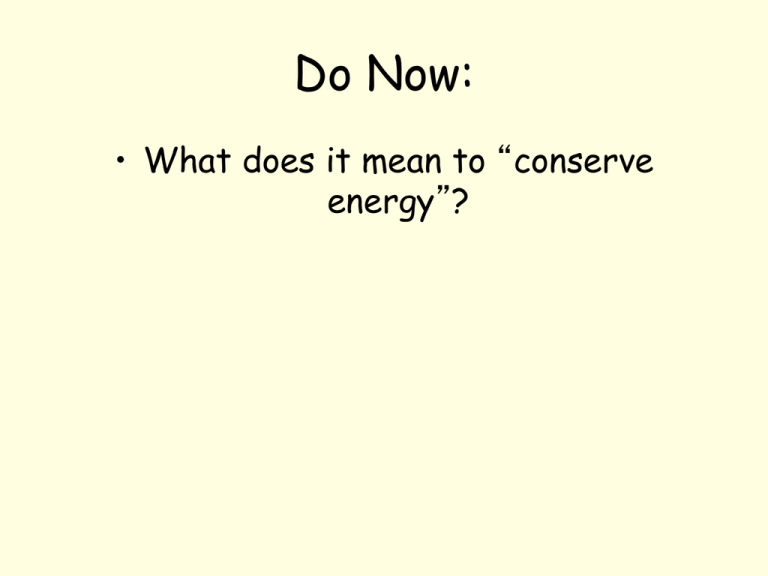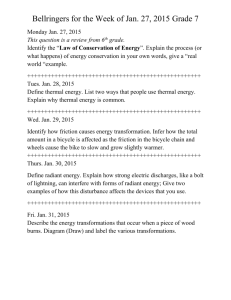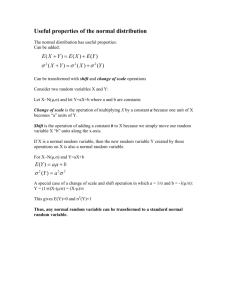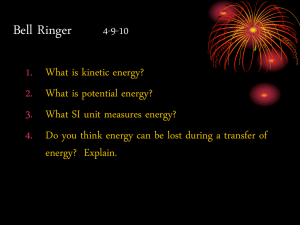Transformations and Conservation
advertisement

Do Now: • What does it mean to “conserve energy”? Energy Transformations and Conservation Energy Transformations • What does flowing water have to do with electricity? • You may already know that the mechanical energy of moving water can be transformed into electrical energy. Most forms of energy can be transformed into other forms • A change from one form of energy to another is called an energy transformation. • Some energy changes involve single transformations, while others involve many transformations. Single Transformations • Sometimes, one form of energy needs to be transformed into another to get work done. • For example, a toaster transforms electrical energy to thermal energy to toast your bread. • A cell phone transforms electrical energy to electromagnetic energy that travels to other phones. • Your body transforms the chemical energy in your food to mechanical energy you need to move your muscles. • Chemical energy in food is also transformed to the thermal energy your body uses to maintain its temperature. Multiple Transformations • Often, a series of energy transformations is needed to do work. • For example, the mechanical energy used to strike a match is transformed first to thermal energy. • The thermal energy causes the particles in the match to release stored chemical energy, which is transformed to thermal energy and the electromagnetic energy you see as light. • In a car engine, another series of energy conversions occurs. • Electrical energy produces a spark. • The thermal energy of the spark releases chemical energy in the fuel. • The fuel’s chemical energy in turn becomes thermal energy. • Thermal energy is converted to mechanical energy used to move the car, and to electrical energy to produce more sparks. Transformations Between Potential and Kinetic Energy • One of the most common energy transformations is the transformation between potential energy and kinetic energy. • In waterfalls such as Niagara Falls, potential energy is transformed to kinetic energy. • The water at the top of the falls has gravitational potential energy. • As the water plunges, its velocity increases. • Its potential energy becomes kinetic energy. Swinging Pendulum Energy Transformation in a Pole Vault • The pole-vaulter has kinetic energy as he runs forward. • When the pole-vaulter plants the pole to jump, his velocity decreases and the pole bends. • His kinetic energy is transformed to elastic potential energy in the pole. • As the pole straightens out, the pole-vaulter is lifted high into the air. • The elastic potential energy of the pole is transformed to the gravitational potential energy of the pole-vaulter. • Once he is over the bar, the pole-vaulter’s gravitational potential energy is transformed back into kinetic energy as he falls toward the safety cushion. Conservation of Energy • If you set a spinning top in motion, will the top remain in motion forever? • No, it will not. • Then what happens to its energy? • Is the energy destroyed? • Again, the answer is no. • The law of conservation of energy states that when one form of energy is transformed to another, no energy is destroyed in the process. • According to the law of conservation of energy, energy cannot be created or destroyed. • So the total amount of energy is the same before and after any transformation. • If you add up all the new forms of energy after a transformation, all of the original energy will be accounted for. Energy and Friction • So what happens to the energy of the top? • As the top spins, it encounters friction with the table and friction from the air. • Whenever a moving object experiences friction, some of its kinetic energy is transformed into thermal energy. • So, the mechanical energy of the spinning top is transformed to thermal energy. • The top slows and eventually falls on its side, but its energy is not destroyed—it is transformed. • The fact that friction transforms mechanical energy to thermal energy should not surprise you. • The fact that friction transforms mechanical energy to thermal energy explains why no machine is 100 percent efficient. • You may recall that the output work of any real machine is always less than the input work. • This reduced efficiency occurs because some mechanical energy is always transformed into thermal energy due to friction. Closure: Describe the energy transformations that occur in a clothes dryer


